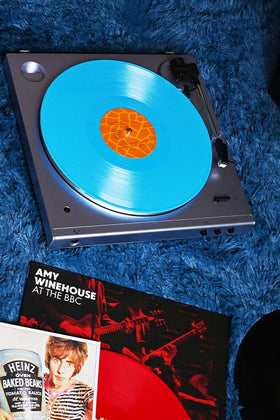Moving Coil vs. Moving Magnet Turntable Cartridges
Turntable cartridges are one of, if not the, most important parts of a record player. They’re the part of a turntable that transmits sound from the record to the speakers, so any listener needs to make sure that they choose the best cartridge for their sound system.
This blog post will give you a quick overview of the two functional types of turntable cartridges: moving coil and moving magnet. We’ll tell you the differences between the two and how they work and give you some tips on which one might be best for you.
What Is a Turntable Cartridge?
A turntable cartridge is a device that reads the grooves on a record and turns them into audio signals. They’re also called magnetic cartridges, phono cartridges, or moving coil cartridges. If you look at your record player, you’ll find the turntable cartridge attached to the end of the mechanical arm that raises and lowers over your record (the tonearm).
Turntable cartridges can be made from many different materials, from plastic and metal to hardwood and precious stones. They’re usually only a couple of inches long, and every turntable cartridge has a few of the same components. Those components are a small magnet, wire coils, and a needle tipped with diamond or another precious stone.
Turntable cartridges often reflect the expense of the rest of the turntable. If you have a higher-end record player, your cartridge will probably be made of teak, mixed metal, or even gold. A less specialized turntable will have a cartridge made of aluminum, plastic, or particle wood.
If you want to know more about turntable cartridges, we’ve put together a handy guide here.
Moving Coil vs. Moving Magnet: What’s the Difference?
The main difference between the two types of coil is how they function mechanically. The key to this is in their names. A moving magnet cartridge has static coils and a moving magnet. A moving coil cartridge has a magnet that stays still while the coils vibrate.
Moving coil cartridges are lighter than moving magnet cartridges. They are also more complex and more difficult to maintain unless you’re an expert. This is partially because the mechanism that moves coils is lighter and more intricate than one that moves magnets. Because of their lightness and intricacy, moving coil cartridges are more precise and create a more delicate sound.
Moving Coil vs. Moving Magnet: Who Wins?
If you’re trying to decide which type of cartridge is better for your record player, it’s essential to know the pros and cons of both. Here’s a quick rundown of the benefits and drawbacks of each type of cartridge.
Moving Magnet Turntable Cartridges
The key factors to remember about moving magnet cartridges are that they’re heavier, easier to maintain and install, and less expensive.
The pros of moving magnet turntable cartridges include:
- High Output – Moving magnet cartridges produce a nice, steady, and consistently loud sound that works well with standard amplifiers and doesn’t require special knowledge to get set up.
- Easy Maintenance – If a magnet needs to be replaced or adjusted inside of a moving magnet cartridge, the user can do that themselves with a little guidance.
- Highly Compatible – Record players with moving magnet cartridges tend to be easier to set up. The high output from the cartridge makes it easier to connect to household stereo equipment.
- Less Expensive – Moving magnet turntable cartridges are a less expensive option. They cost less to manufacture because they literally have fewer moving parts than the alternative. This makes them a good option for starter audiophiles experimenting with their first sound system.\
The cons of moving magnet turntable cartridges include:
- Heavy – Moving magnet cartridges are heavy and need to be set up at a very precise angle with a specific amount of pressure to avoid causing wear on records. This can be helped by choosing a narrower stylus in some cases.
- Less Nuanced Sound – Because magnets are less delicate than wire coils, the sound you get with a moving magnet turntable cartridge is a little meatier and less nuanced. For some genres of music, this sound works well, but if you’re an extreme audiophile, you might feel like you’re missing some of the music with a moving magnet cartridge.
Moving Coil Turntable Cartridges
The key takeaways for moving coil turntable cartridges are that they’re lighter, with a more precise sound. However, they’re also more expensive and harder to fix.
The pros of a moving coil turntable cartridge include:
- Light – The coils in a moving coil cartridge are lighter than those in a moving magnet cartridge. This is because they need to be lighter to vibrate and move effectively and still make contact with the wires in the back of the cartridge that connects to the speakers. This makes it easier to manage the angle and pressure of the cartridge as it touches your records.
- More Nuanced Sound - Vibrating coils pick up more of the delicate changes in the texture of the record as the stylus moves across them. This makes the resulting sound fuller, with more precise highs and lows. If you have a sensitive ear, the benefits of a moving coil cartridge will be noticeable.
The cons of a moving coil turntable cartridge include:
- More Expensive – A quality moving coil cartridge costs significantly more than a moving magnet cartridge does. This is partially because they cost more to manufacture and have more delicate coils. They also tend to be made of higher-end materials.
- More Difficult Maintenance – If something goes wrong with your moving coil cartridge, you’ll need to get professional help to fix it. While a magnet can be replaced by a newbie with a little guidance, moving coils are delicate and need to be attached very precisely to work correctly. If you get a moving coil cartridge, it pays to be prepared for the extra expense of repairs or replacement if something goes wrong.
Moving Coil vs. Moving Magnet: Which One Should You Choose?
Even when you have all of the information laid out, the choice between moving coil and moving magnet cartridges can seem less than clear. Ultimately, it comes down to a simple question: what are you using your record player for?
Audiophiles tend to prefer moving coil cartridge models because the sound they produce has much more clarity and precision. They go well with higher-end record players and speakers, so try a moving coil cartridge if you are a dedicated sound hobbyist who plays records specifically to focus on the sound.
Consider a moving magnet cartridge if you’re not a serious audiophile and mostly play music in the background, at loud parties, or in other non-focused contexts. They’re also good for DIY sound system enthusiasts because they have a more accessible design.
If you want to get some records to test the sound of your new turntable cartridge on, be sure to take a look at the Sound of Vinyl store.
Sources
Moving Magnet vs. Moving Coil Phono Cartridges | Definitive Guide | Record Player Pros
Best cartridges 2022: budget and premium options for your turntable | What Hi-Fi?
How to Choose Your Next Turntable Cartridge or Stylus | Lifewire




